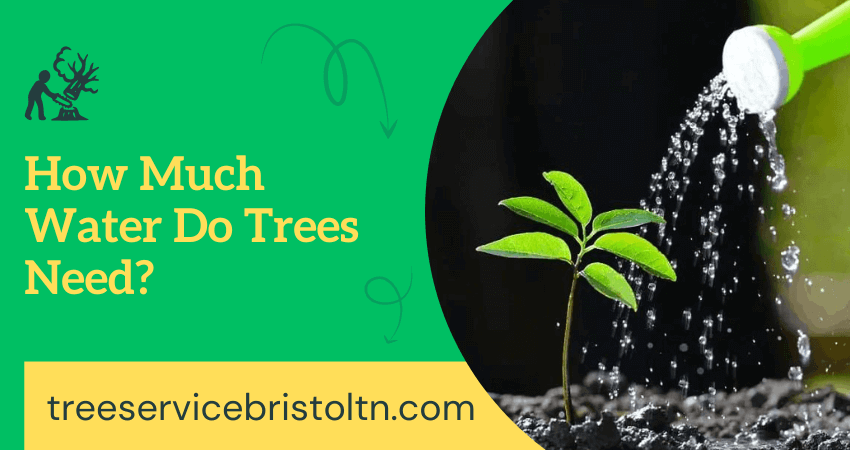Proper watering is essential for the health and survival of trees and shrubs. However, determining how much water to give them can be challenging. Overwatering can lead to root rot, while underwatering can cause the plant to become stressed and susceptible to disease.
In this blog post, we will discuss the factors to consider when determining the appropriate watering schedule for your trees and shrubs, as well as tips for ensuring they receive the right amount of water.
Read on as we uncover the methods of watering and Common mistakes to avoid when watering your plants.
How Much Water Do Trees Need?
Watering your trees and shrubs correctly is an important part of keeping them healthy. Generally, most plants should be watered deeply (1-2 inches) once a week during the growing season, unless there is adequate rainfall. It’s best to water in the morning or evening when temperatures are cooler and the winds are calmer. This will help reduce moisture loss from evaporation.
For young trees and shrubs, it’s best to water them more frequently and deeply, especially during the first two years after planting. During this time, they are establishing their root systems which means they require additional watering to help them grow.
Once your trees and shrubs are established, you can reduce the frequency to 1-2 times a week. In addition, mulching your plants helps to retain moisture in the soil and reduce evaporation.
Factors That Affect Tree Watering Needs
Watering needs can be affected by a variety of factors, including:
1) Climate and weather conditions
Climate and weather conditions can have a direct impact on how much water plants need. Areas that experience high temperatures, low humidity and low rainfall will require more frequent watering than those that experience cooler temperatures and higher rainfall. Rainfall and temperatures should also be taken into account when estimating the amount of water needed.
2) Soil type and drainage
Soils with good drainage help ensure that the soil remains moist for an adequate amount of time after irrigation. Clay soils are more likely to retain moisture for a longer period than sandy soils, so the amount of water needed can vary based on the type of soil.
3) Tree and shrub species
Different species of trees and shrubs may require different amounts of water. For example, evergreens typically need more water than deciduous plants because they remain green throughout the year and do not go dormant as deciduous plants do in winter months.
4) Age and size
The age and size of a tree or shrub can also affect how much water it needs. Young plants may need to be watered more often than mature ones and larger plants may require more water due to increased surface area.
In general, however, it is best to water deeply and infrequently rather than lightly and frequently.
How to determine watering needs?
To determine the watering needs of your tree or shrub you should use a moisture meter, finger test, observe the plant’s leaves and branches and check the soil moisture level.
1. Use of a moisture meter
A moisture meter or a finger test is the most accurate way to determine when your tree or shrub needs water. Inserting the moisture meter into the soil will give you an exact reading of how much water is in the soil and can tell you if it’s time to water. To use the finger test, insert your index finger into the soil and feel around for dampness.
2. Use of finger test
To use the finger test, insert your index finger into the soil and feel around for dampness. If the soil feels dry, it’s time to water.
3. Observe the plant’s leaves and branches
Take a look at your tree or shrub’s leaves and branches to indicate how much water it needs. If the leaves are wilting, curling up or turning yellow, it’s a sign that the plant is not getting enough water. The plant has plenty of water if they are crisp and vibrant in color.
4. Checking the soil moisture level
The best way to determine how much water your tree or shrub needs is by checking the soil moisture level. Dig down into the top few inches of soil and feel the texture.
It’s important to remember that different plants have different watering requirements, so be sure to research your specific plant before determining how often to water it.
Best Methods Of Watering
There are several methods for watering and each has its advantages.
This is a great way to deliver water directly to the roots of your trees and shrubs, as it slowly seeps into the soil around them. This method is especially beneficial for plants in containers or with restricted root systems.
2) Soaker hoses
These are useful for giving larger areas of your garden a thorough soaking, as they allow you to water a wide area without wasting excess water.
3) Surface watering
This is the simplest way to provide your plants with enough moisture and small gardens in particular can be just as effective. By using a sprinkler or watering can, water is distributed over the entire surface of the soil, which can then be absorbed by the plants.
4) Deep watering
This is sometimes overlooked, but deep watering is an important part of watering your plants. Watering deeply encourages the roots to grow deeper into the soil, which increases their ability to find water and nutrients even in dry conditions.
Deep watering should be done every few weeks and it is best done after the top inch or two of the soil has dried out.
No matter what method of watering you choose, it is important to remember that overwatering can be just as harmful to your plants as under-watering.
Common Mistakes To Avoid While Watering Trees
There are some common mistakes to avoid when watering your plants:
1) Watering at the wrong time of day
Watering during the heat of the day can cause the water to evaporate before it has a chance to reach the roots of your plants. Watering in the morning or evening is best, as this allows enough time for the water to soak into the soil.
2) Not adjusting your watering schedule
Many plants only need to be watered once a week, however, this may vary depending on the type of plant you have and the local climate. You should adjust your watering schedule accordingly to ensure that your plants receive the right amount of water.
3) Overwatering or underwatering
It is important to get the balance right when watering your plants. Too much or too little water can cause a range of problems, from wilting and drooping leaves to root rot. Make sure you are aware of how often each type of plant needs to be watered to keep it healthy.
4) Watering the foliage instead of the soil
It is important to water the soil, not the foliage. The roots of the plant will absorb the moisture and nutrients from the soil, so it is important to make sure that you are providing enough moisture in this way. Watering the leaves of a plant can cause fungal diseases which can damage or even kill your plants.
5) Not using mulch
Mulch is a great way to help retain moisture in the soil, as it helps to slow down the evaporation of water. Make sure you spread a layer of mulch around your plants to help keep moisture in and weeds out.
Following these tips will ensure that your plants receive the right amount of water at the right time, enabling them to thrive and stay healthy. Taking the time to water your plants correctly will help ensure that they reach their full potential.
Conclusion
Remember that different types require different amounts of water, so knowing what species you have on hand is essential before beginning a watering regime. It is important to not over-water or under-water your trees and shrubs, as both can cause damage.
A general rule of thumb is to give your trees and shrubs about 1 inch of water per week, either through rainfall or manual watering. However, it is always best to consult the specific watering needs of the individual species of tree or shrub you are caring for.
Additionally, regularly checking the soil moisture, monitoring the weather and observing the plant’s health can help you to adjust the watering schedule as needed. With the right amount of knowledge and care, you can give your trees & shrubs the moisture they need.



